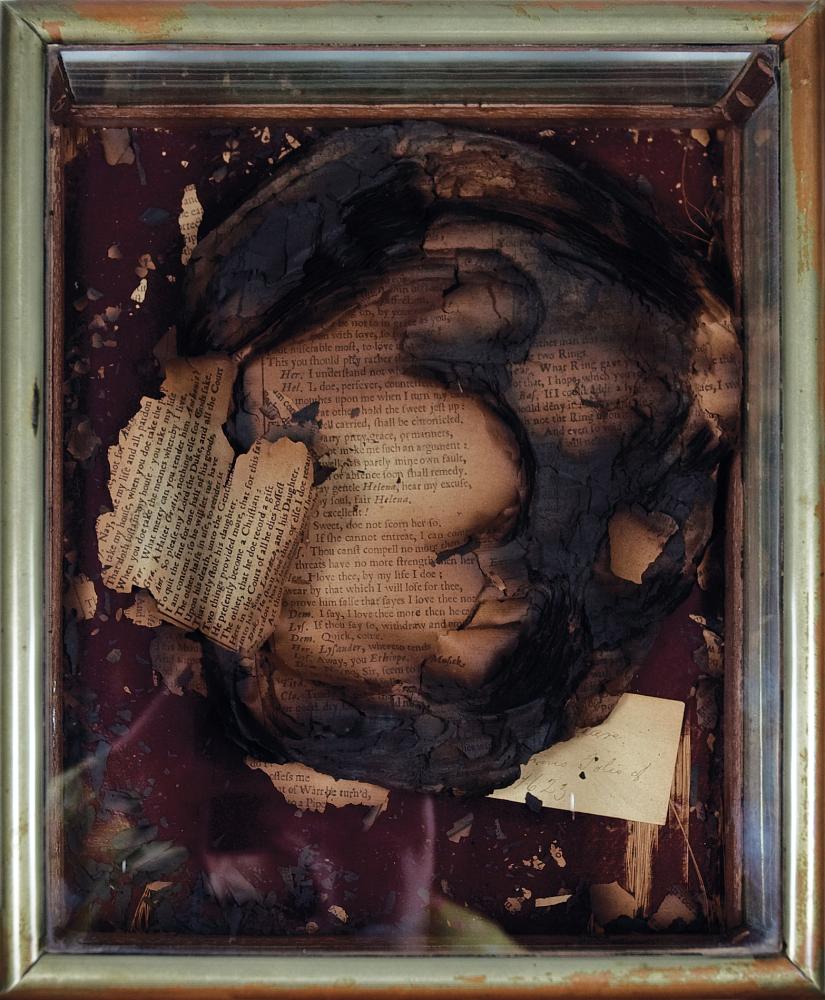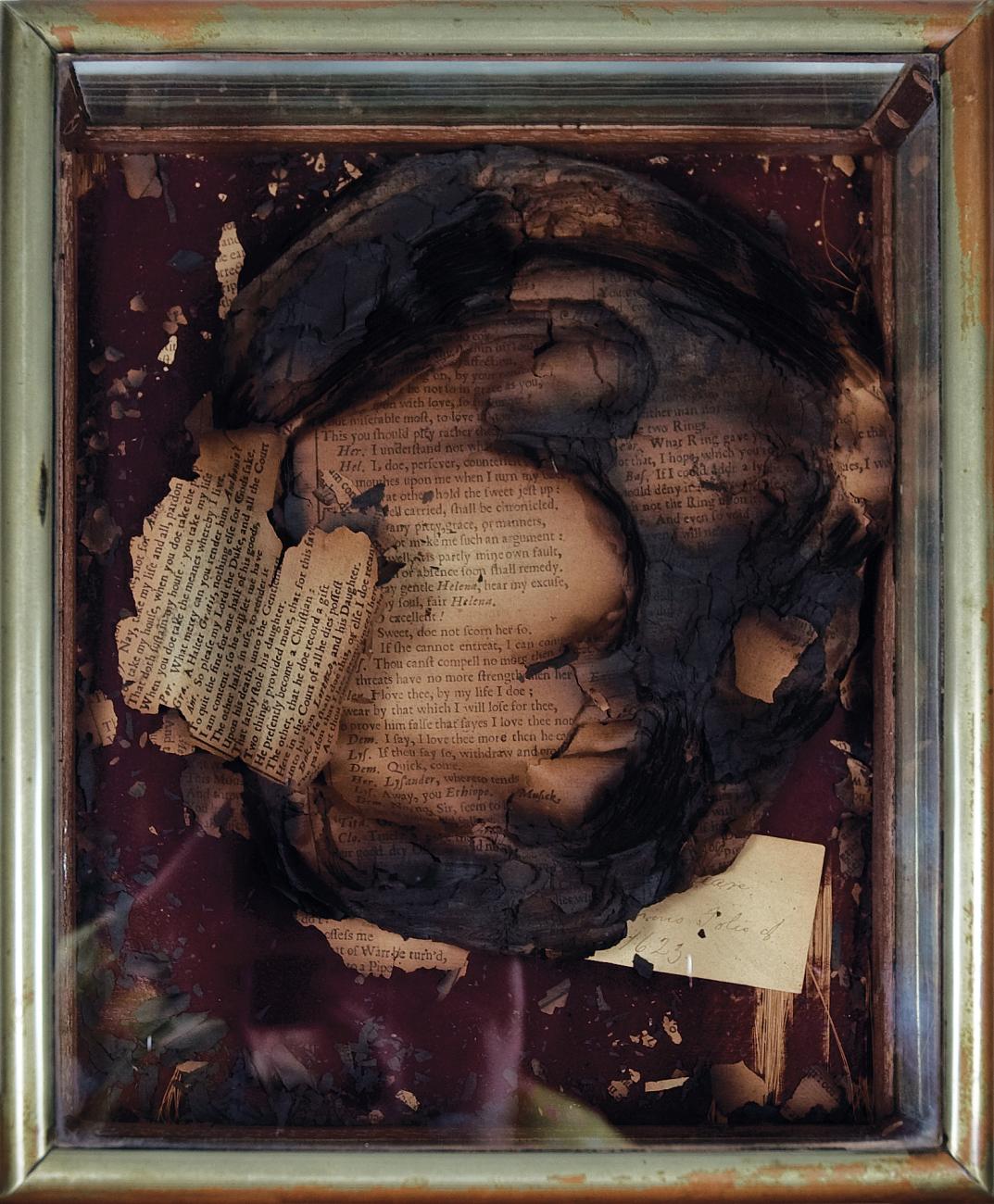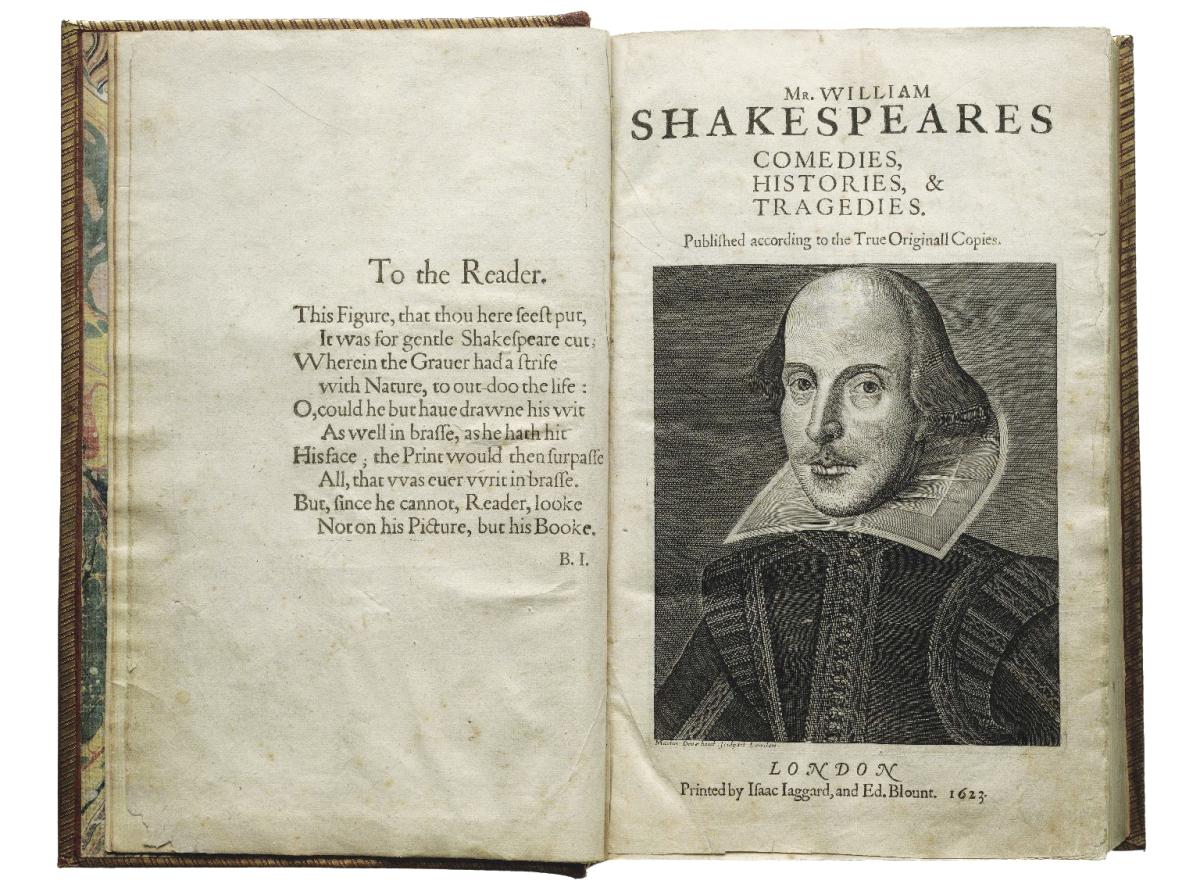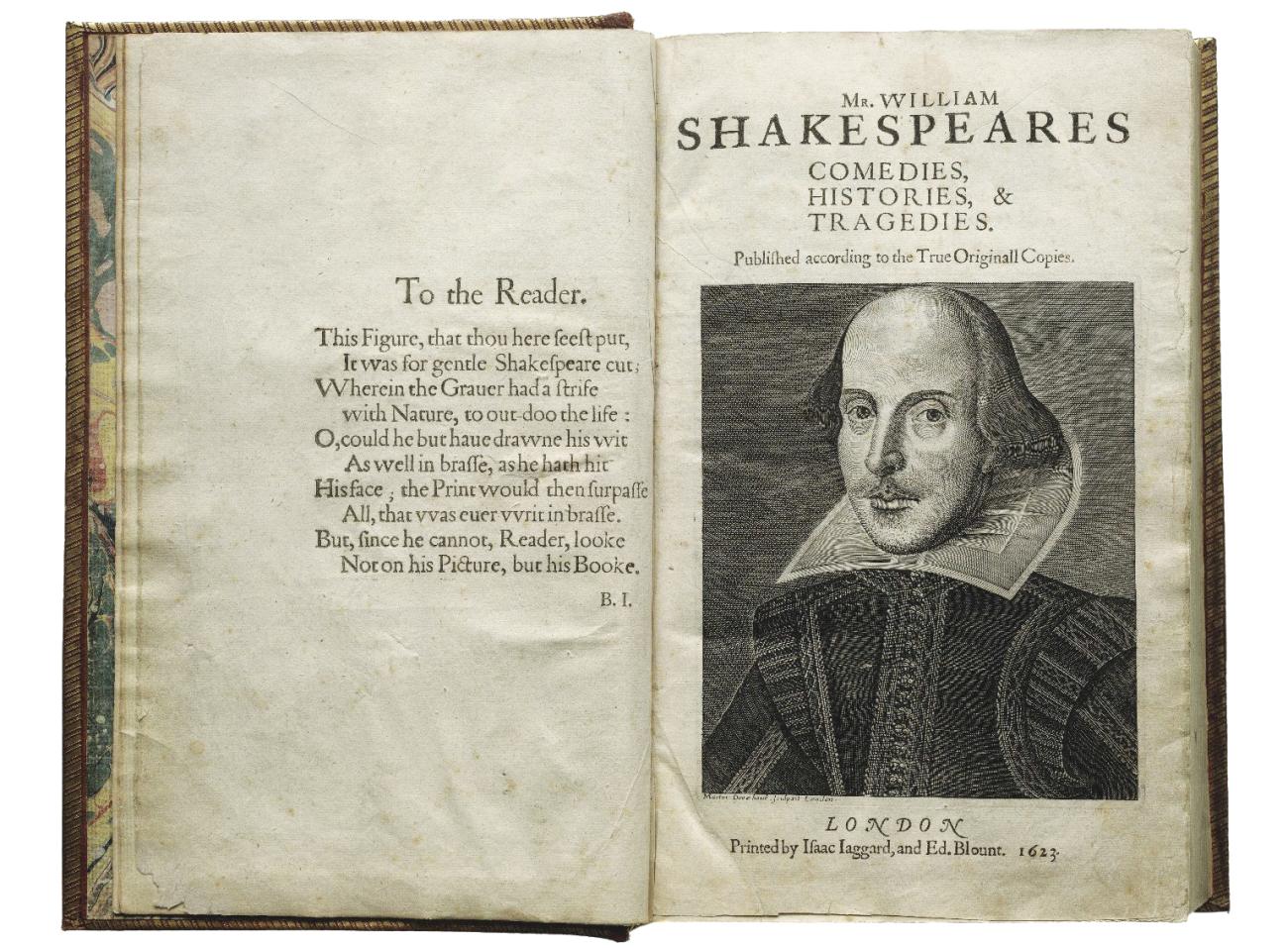Hidden away in a storage area of the Kislak Center at the University of Pennsylvania is an odd display case. It is a rectangular glass container—a small reliquary, one might call it—containing scorched fragments of a few pages of an early printed book. Bits of text are legible on some of the burned leaves, but mostly they are just blackened scraps of paper.
They are what survive of a copy of Shakespeare’s First Folio that had belonged to the nineteenth-century American actor Edwin Forrest. One month after his death in December of 1872, a fire reduced what had been his most precious possession to these few charred remains.
Forrest’s house on Broad Street in Philadelphia was saved, and Forrest’s will provided for it to be established as the “Edwin Forrest Home for Decayed Actors.” The surviving books were maintained as a library for the use of the residents, and the remnants of his First Folio, carefully gathered up and entombed in their glass case, were conspicuously displayed until the home was closed in 1986. Soon after, the entire collection was acquired by the University of Pennsylvania.
Depending, then, on what you mean by the word “surviving,” Forrest’s folio is one of about 230 surviving copies of what is, to any book lover, among the most precious of early printed books. To mark the four-hundredth anniversary of Shakespeare’s death, the Folger Shakespeare Library in Washington, D.C., is sending 18 of its extraordinary collection of First Folios on tour, enabling all fifty states to put a First Folio on public display at some point in 2016. This is a wonderful testimony to the astonishing holdings (and generosity) of the Folger and to the remarkable interest there is in Shakespeare. But it was not always so easy to imagine the First Folio going on a grand tour—or its charred fragments lovingly preserved. Indeed, there might never have been a First Folio at all.
The First Folio was not, of course, the first book printed in a folio format. (“Folio” is the bibliographic term for a book made from gatherings of sheets of paper, each folded once along the longer side to make two leaves—or four pages.) The First Folio is merely the first appearance of Shakespeare’s plays in a folio format, and it is a mark of Shakespeare’s extraordinary prestige that the volume of his collected plays could claim the word “folio” as its own. Previously, 19 of his plays had appeared in small, individual volumes, almost all published in “quarto” formats. (For a “quarto,” each sheet of paper was folded twice, to produce eight smaller pages, and then gathered.)
But, in 1621, five years after Shakespeare’s death, a group of publishers began the project of printing a collection of Shakespeare’s plays. Eventually, they would secure the rights to publish the 19 plays that had already appeared in print (though Pericles, which had been published in 1609 and whose rights they owned, was inexplicably left out), and they would establish their rights to publish the 18 plays that had not yet been published and belonged to The King’s Men, the acting company for which they were written.
In 1623, the volume finally appeared. It is undeniably an impressive book, with 36 plays printed on over 900 double-columned pages, an engraved portrait of Shakespeare, a dedication to two influential aristocrats, along with other prefatory materials, all attesting to the ambition of the publishers to create a living monument to Shakespeare.
The Shakespeare Folio is a cultural treasure. But it is not really a particularly rare book. There are, relatively, a lot of them around. (There are 82 in the Folger Library alone.) Many early books survive in only one or two copies, and we know of many others that were definitely published but of which no copies can be found. The Shakespeare Folio was published in an edition of probably no more than 800 copies. More than a quarter of these survive, which probably means less that it was immediately recognized as being of extraordinary value than that it was very well-bound but not energetically read. And most of these have found their way to major institutional libraries, where they are proudly displayed and occasionally consulted by scholars.
From our perspective, the publication and subsequent importance of the First Folio seem the inevitable and appropriate tribute to Shakespeare’s genius. Certainly we are fortunate that we have the book. After all, without it, we would not have 18 of the plays—including The Tempest, Macbeth, Twelfth Night, and As You Like It. But the book was not as inevitable as it seems to us today. We easily might not have it.
Shakespeare himself seems to have had no interest in collecting his plays, or even in publishing individual ones. In his lifetime, almost half were not published, and of the ones that were published many appeared without his name on the title page. Legally, in any case, the scripts belonged to the acting company, of which, admittedly, Shakespeare was a part owner. And, until 1710, a publisher, having come into possession of a manuscript, could legally publish it without regard to the author’s wishes. Only with the new law were authors granted the rights to the “Property” of their “Books and Writings, as the Product of their Learning and Labour.” So, Shakespeare’s plays weren’t exactly his.
He seems to have thought a bit differently about his two narrative poems. Shakespeare contributed dedications to Venus and Adonis and Lucrece, but wrote nothing similar for any of the published plays. Other playwrights seemed more interested in asserting their authorship—their moral authority over the text if not their legal one. They often claimed the published play text as an opportunity to establish what they had actually written rather than what was played in the theater. Richard Brome, for example, writes in an epistle for his Antipodes that the printed play contains “more than was presented upon the Stage,” where, “for superfluous length (as some of the Players pretended),” cuts were made. For Brome, as for other playwrights, print was important for restoring and preserving the play he wrote.
Shakespeare, however, never asserted any such proprietary right to his play texts, though his own plays must have similarly been subject to the inevitable cuts and rearrangements of performance. Nor did he express any anxiety about the form in which they appeared in print. And, most significantly, he seems to have made no effort at all to ensure that his plays were collected.
“It is foolish to suppose,” insisted the great twentieth-century scholar W. W. Greg, “that Shakespeare was indifferent to the fate of his own work.” But indifferent he seems to have been. Perhaps he did care, though in truth nothing beyond the unactable length of some of his play texts suggests that he ever imagined their publication. (And their length might well point merely to writerly self-indulgence rather than a commitment to print.) Greg, however, wondered if Shakespeare did not “dream in his garden at Stratford of a great volume of his plays, such as his friend Jonson was busy preparing.” But this seems to say less of Shakespeare’s dreams than it does of his bibliographers. Only they dream of authorized editions.
In 1616, the year of Shakespeare’s death, a volume entitled The Works of Benjamin Jonson was published, with nine of Jonson’s plays along with various poems, masques, and other entertainments. Shakespeare and Jonson knew each other well, and Shakespeare must have been aware of the project for collecting Jonson’s Works. It could have sparked a desire for something similar for himself. But there is no evidence that it did. Nothing Shakespeare ever did suggests anything other than that he thought as his contemporary Thomas Heywood did. “It was never any great ambition in me,” wrote Heywood, “to be in this kind Voluminously read.” Shakespeare seems to have felt exactly the same way. He just went home to Stratford once he stopped writing for the theater. There’s no sign of him ever having ambitiously dreamed of a volume of his collected works.
Whoever’s idea the Shakespeare Folio was, it wasn’t Shakespeare’s. It was almost certainly the idea of two of his longtime friends and fellow actors: John Heminge and Henry Condell. Several years after Shakespeare’s death, the two men conceived of the project, as they say, “without ambition either of self-profit or fame,” but “only to keep the memory of so worthy a friend and fellow alive.” In his will, Shakespeare had left each of them money for a memorial ring. With the Folio, they revealed how fully they did remember him and provided for him to be remembered. But getting the volume printed wasn’t easy.
Heminge and Condell arranged with a successful London printer and publisher, William Jaggard, to produce the book. They knew Jaggard, as he was the printer of the playbills that served as their acting company’s advertising. Jaggard, however, had a vexed relationship with the publication of Shakespeare’s work. In 1599, he had published a collection of poetry, The Passionate Pilgrim, with the title page proclaiming it was “By W. Shakespeare,” though only five of the 20 poems are actually by Shakespeare: two sonnets and three passages from Love’s Labor’s Lost. The volume attracted little attention until 1612, when it was republished and significantly expanded, announcing on its title page that the new edition has “added two Love Epistles, the first from Paris to Hellen, and Hellen’s answere back again to Paris.” These were both by Thomas Heywood and had been published in his Troia Britannica in 1609, though Shakespeare’s name continued to appear alone on the title page of The Passionate Pilgrim.
Understandably, Heywood was upset, and, in an introduction to his Apology for Actors (1612), he complained about the inclusion of his work. It wasn’t a copyright violation; Jaggard owned the copyright. Heywood, however, protested “the manifest injury” done to him by publishing his poems under Shakespeare’s name, since it might now seem to readers that he had stolen them from Shakespeare in 1609 and that Shakespeare, in order to claim them as his own, now “published them in his own name.” He also said that Shakespeare “was much offended with” Jaggard for making “so bold with his name.” Other than Heywood’s comment, we know nothing of Shakespeare’s response to the episode. But Jaggard did cancel the title page of the unsold copies and reissued the volume without the claim of Shakespeare’s authorship.
And that is not the only time that Jaggard was involved with a publication that was less than straightforward about its publishing claims. In 1619, Jaggard and another publisher, Thomas Pavier, collaborated on what was intended to be an edition of ten plays by Shakespeare, though two of these—A Yorkshire Tragedy and 1 Sir John Oldcastle—were misattributed to Shakespeare, either in ignorance or as a deliberate fraud. But what is unquestionable is that the internal title pages for individual plays were in a number of cases deliberately misdated, presenting newly printed texts as older publications, some dated as early as 1600 although all were printed in 1619.
What seems to have happened is that The King’s Men had learned of Pavier and Jaggard’s project, and were able to get a governmental order issued (they were, after all, The King’s Men) requiring that no plays belonging to the company be printed without their permission. Pavier and Jaggard, having already begun printing the plays, had only two choices. They could abandon the project, though they had already invested a lot of money in paper and labor, or they could make it look as if these plays were merely old stock and thus safely sold. And this latter course is the one they chose. Having begun a collection (the first three plays are clearly printed to appear sequentially), they printed the rest as if they were each single volumes that had been published earlier, and offered them all for sale—probably available both individually and as a collection, though only a handful of collected volumes have survived. Given Jaggard’s involvement both with this project and with The Passionate Pilgrim, one might well ask why Heminge and Condell would turn to him to print the Folio. The answer seems to me simple. He was willing to do it.
Looking back through the centuries it must seem that the opportunity to be involved with Shakespeare’s First Folio would have been a publishing coup. At the time, however, it more likely seemed an incredible risk. The large book demanded an extraordinary initial investment. Unlike many forms of manufacture, with a printed book you can’t sell a single copy until all the copies are printed. The publisher must front all of the costs, and it could take years to turn a profit.
We assume that Shakespeare’s plays were valuable. They weren’t. They were just play scripts. We assume they must always have been best-sellers. Some were; most weren’t. We assume there was a steady growth of interest in the plays, justifying the collected edition. But, in fact, no play by Shakespeare had appeared in print for four years prior to Pavier and Jaggard’s project in 1619. Perhaps it was the experience with Pavier that convinced Jaggard that there was a market for these plays when Heminge and Condell approached him several years later. He said yes when he was asked if he would publish them, and arguably the two actors knew no one else who would.
In the 1622 catalog of English books that were available for sale at the biannual Frankfurt book fair, there is an advertisement for “Playes, written by M. William Shakespeare, all in one volume, printed by Isaak Jaggard, in fol.” Isaac Jaggard was William’s son, and he had taken on much of the responsibility for the family business, as his aging father had gone blind. Clearly they had hoped the book would be available for sale, but it would not appear until the following year.
Printing the book proved complicated, in part because there were delays in acquiring rights to certain plays, but also because it wasn’t always the highest priority in the printing house. The presses stopped printing the First Folio to work on several other books, perhaps most importantly, from Jaggard’s point of view, a book of heraldry by Augustine Vincent. Vincent’s book exposed numerous errors in the work of another herald, Ralph Brooke. When some of Brooke’s mistakes had earlier been identified, Brooke had blamed them on the sloppy work of the printer and publisher, who had been Jaggard. Vincent showed that the errors were matters of fact, not of typography, and Jaggard defended his reputation in a preface, insisting that proof copies had been sent daily to Brooke, so any errors were his own fault. Shakespeare was certainly not as important as this.
Late in 1623, however, the Shakespeare Folio was finally finished. William Jaggard had died several weeks before. William Shakespeare had been dead for seven years. But Heminge and Condell’s monument to their friend had reached print. But even then, in what might seem the safest of circumstances, the book’s fate was precarious.
Isaac Jaggard sent the sheets for the deposit copy to the Bodleian Library at Oxford. In 1610, Thomas Bodley had arranged for “one perfect book” of every work printed in England to be sent to the library that he had established at the university, though initially he had excluded “almanacs, plays, and proclamations” as ephemera unworthy of collection. There might be “some little profit” to be “reaped . . . out of some of our playbooks,” he wrote to his librarian, but not enough to counteract “the scandal” to the library if such unsuitable “riff-raff” were allowed in.
Bodley died in 1613, and gradually playbooks would find their way into the library, though by 1620 they still owned no plays by Shakespeare, Marlowe, Jonson, or Beaumont and Fletcher. But the unbound sheets of the Shakespeare Folio were sent to the university binder (who bore the wonderful name, William Wildegoose) on February 17, 1624; and it was bound and chained, as most big books were, to a shelf in Duke Humphrey’s Library. It stayed there until 1664, when it was apparently deaccessioned (as librarians say) as one of a group of “superfluous Library Books sold by order of the Curators” and purchased by an Oxford bookseller for 24 pounds.
What made the book “superfluous” was that a new edition had appeared that year that seemed better able to deliver the plays written by Shakespeare: the second issue of the third edition of the Folio collection. It seems to us an unthinkable, even an irresponsible, decision on the part of the library. But, in 1664, the second issue of the third edition reasonably seemed the more desirable to own, rendering the First Folio “superfluous.” This new version boasts that “unto this Impression is added seven Playes, never before Printed in Folio. Viz. Pericles, Prince of Tyre. The London Prodigall. The History of Thomas Ld. Cromwell. Sir John Oldcastle Lord Cobham. The Puritan Widow. A Yorkshire Tragedy. [and] The Tragedy of Locrine.”
More Shakespeare is obviously better than less. This edition of the Third Folio was more complete than any that came before. And the new, more complete Shakespeare was what was republished in 1685 in the Fourth Folio, and indeed again in 1709 when Nicholas Rowe published his six-volume edition of the plays.
There are many ironies to this, not least that two of these plays are the two not by Shakespeare that Pavier and Jaggard had misattributed to him in 1619: A Yorkshire Tragedy and 1 Sir John Oldcastle. Indeed, of the belatedly added plays only Pericles has made its way into the canon. The others have become part of an “apocrypha.” They are the ones not written by Shakespeare. But it is not clear how anyone could have known this in 1664 or 1685 or 1709. In addition to the two “Pavier” plays that were published as Shakespeare’s, The London Prodigal had been published in 1605 as “By William Shakespeare”; The History of Thomas Lord Cromwell was published in 1602 as “Written by W. S.”; The Puritan Widow was published in 1607 and claimed to have been written by W. S.; and The Tragedy of Locrine was published in 1595 as “By W. S.” All of the added plays had been plausibly identified on earlier title pages as by Shakespeare. It would have been an irresponsible publisher who wouldn’t have wanted to complete his Shakespeare and an irresponsible librarian who wouldn’t have preferred a more complete edition to the abridged one—and even come to think of the First Folio as “superfluous,” since it was not yet a rare or valuable book.
Unlike most stories of loss, the tale of the Bodleian First Folio has a happier ending than that of Edwin Forrest’s First Folio. On January 25, 1905, W. G. Turbutt brought a copy of the Folio, which had been in his family at least since 1760, to the Bodleian to ask about repairing it. The librarian recognized it as the original Bodleian copy, and suggested the library buy it. A price was agreed upon and the money raised by public subscription. It was at the time the most money ever paid for a single English book. It had taken a long time for this First Folio to come home, but it had taken a long time for the First Folio to become, . . . well, the First Folio: a book so precious that even a few charred pages are worth venerating.






